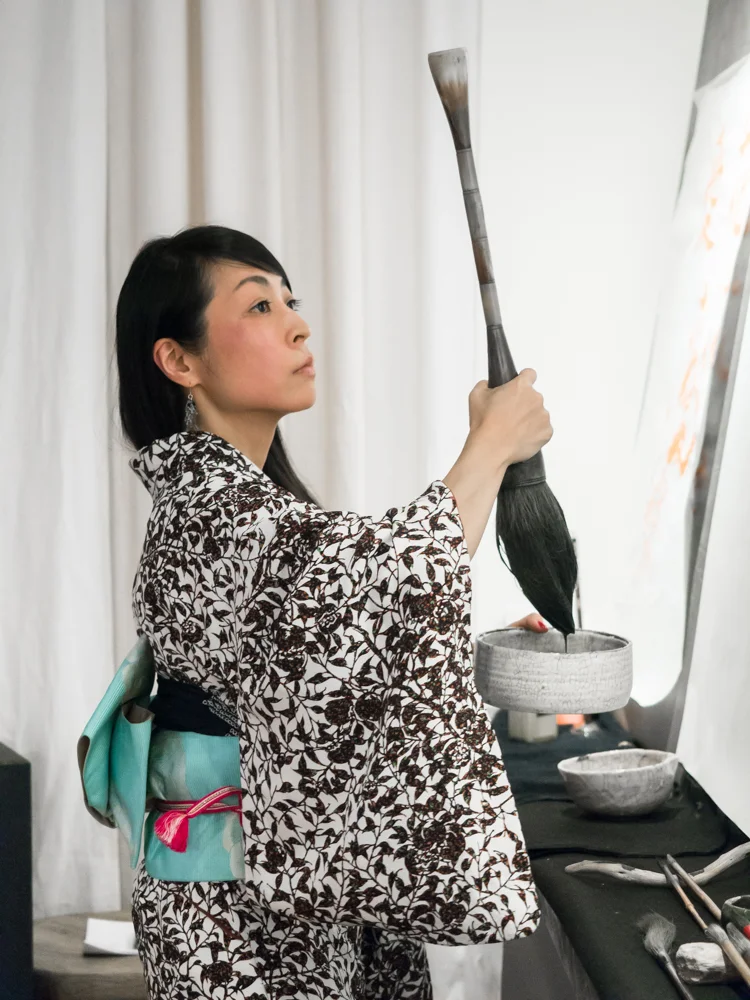Rikumo Workshops: Setsuhi Shiraishi's Neo-Calligraphy
On September 17th our concept store had the honor of hosting Setsuhi Shiraishi, a Japanese master calligraphist and performance artist. Accompanied by jazz music, Setsushi created two large-scale works of calligraphy on paper before a live audience: one on the floor between the crowd, and another against a flat wall. The beauty of her brushstrokes was only heightened by the music- much like jazz, the true artistry of calligraphy emerges when it's improvised. To keep the spirit of artistry going, we're assembled a few choice quotes from Setsuhi herself. Read on to see why calligraphy and music pair so well, and how calligraphy can sometimes show a person's true character.
ジャズピアニストのビル・エバンスは、自身がピアニストとして参加したマイルス・デイビスのリーダーアルバム『カインド・オブ・ブルー』(1959年)のライナーノーツにジャズにおける即興性、書画についての記述があります。
A jazz pianist, the late Bill Evans wrote about calligraphy and jazz improvisation in the liner notes of the album, “Kind of Blue” the groundbreaking Miles Davis’ album made in 1959.
“There is a Japanese visual art in which the artist is forced to be spontaneous. He must paint on a thin stretched parchment with a spacial brush and black water in such a way that an unnatural or interrupted stroke will destroy the line or break through the parchment. Erasures or changes are impossible. These artists must practice a particular discipline, that of allowing the idea to express itself in communication with their hands in such a direct way that deliberation cannot interfere.” - Bill Evans, "Improvisation in Jazz"
プ書道は中国から伝わり、日本で独自の文化を築き今日に至ります。当時、書道は日本の指導者であった貴族や武士には不可欠な教養とされました。書は人となりと言われ、書いた字はその人が反映されると言われています。
そのため、自分自身を磨かなければ、技術が向上しただけでは良い書が書けません。書は人なりという言葉通り、書道は技術だけでなく自身の人格が反映される。
Shodo was imported from China in the sixth or seventh century and has been developed in its own way in Japan until now. In those days, Shodo was an essential part of the education of members of the ruling noble families.
We say Shodo represents his or her personality and reflects the person. Therefore you can not write beautiful calligraphy by only improving technique- you must also grow as a person. Like we say, shodo is personality. Shodo reflects not only technique but also a person's character.
Works of calligraphy are admired for the accurate composition of their characters, of course, but also for the way the brush is handled in their creation, the shading of the ink, and the balanced placement of the characters on the paper. We always look for beauty in balance by writing each letter; Long or short, large or small and line angle.
Shodo is not just written letters. It has artistry, strengthens mental, makes you create artwork that moves someone’s heart. It’s not good and bad. You can convey your thoughts to others with you own calligraphy.
一字一字の長短、大小、斜正、疎密など、変化を持たせて書く中に美的調和を求めています。書道はただ字が書いてあるだけではありません。芸術性を持ち、精神性を鍛え、人の心に響くような作品を作り上げさせてくれます。上手い下手ではなく、自分の想いが込められるので、その想いを伝えることができ
書道は文字の整い具合の他、筆の運び方、墨の濃淡、全体の配置の美しさといった観点から鑑賞するものです。
ここで書と音楽に付いて触れたいと思います。私自身も吹奏楽団に所属して、ホルンを吹いていますが、書道と音楽は勉強の仕方、本番の修正不可能なところや気持ち良い瞬間など共通しているところがたくさんあります。
線には発声と同じように、音色、リズム、ボリュームがあります。 線質、筆勢、墨量と言い換えましょうか。歌にこころがあるように、書道作品にも心があります。
書道は二度書きをしてはいけません。絵画の世界では色の層を重ねたりして作品を仕上げるのは当然なことだが、書道は「一発勝負」の芸術。書道は一回性の芸術であり、再現性はありません。
Let me speak about calligraphy and music. I belong to the wind instrument orchestra and play french horn myself. There are actually many similarities between the two. For example, the way of learning, it’s unfixable, the moments you feel good..
The lines in calligraphy have sound, rhythm and volume just like vocalization. In other words, the lines of the characters, speed of brushing and density of ink. If singing has a heart, so does calligraphy.
We never rewrite in Shodo. Although layering with colors to create artwork is very common in the painting world, Shodo is one-time art and can never be reproduced.
WORDS BY MAGALI ROMAN
PHOTOGRAPHY BY KAZ MORIHATA






